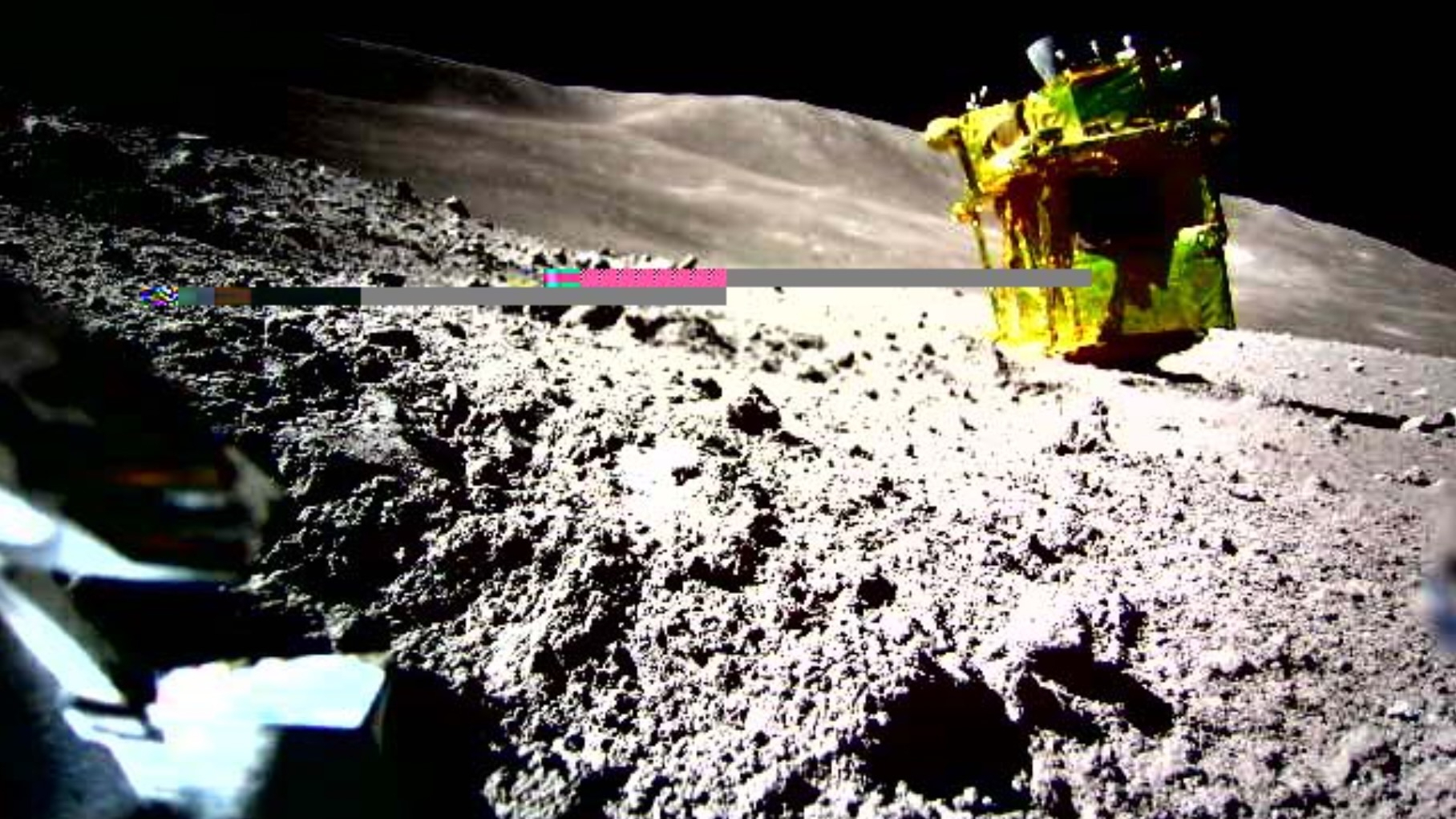Japan just got an epic new photo to put in its space exploration scrapbook.
The country's SLIM spacecraft landed on the moon on Jan. 19, making Japan just the fifth nation ever to pull off a soft lunar touchdown. And a new photo provides visual evidence of that success, showing SLIM resting on the gray dirt, albeit on its nose.
The photo, which the Japan Aerospace Exploration Agency (JAXA) released on Wednesday night (Jan. 24), was taken by a ball-shaped robot called LEV-2 ("Lunar Exploration Vehicle-2") also known as SORA-Q, one of two tiny rovers that flew to the moon aboard SLIM.
"With this, SORA-Q became the first Japanese robot to land on the moon and take pictures," Kintaro Toyama, chairman and representative director of the Japanese toy company Takara Tomy, which developed LEV-2 with JAXA, Sony and Doshisha University, said in a statement (in Japanese; translation provided by Google).
"This success is thanks to everyone involved and everyone who supported us as we pursued our dreams together," Toyama added. "Thank you from the bottom of my heart."
Related: Missions to the moon: Past, present and future

SLIM (short for "Smart Lander for Investigating Moon") is a demonstrator spacecraft, designed to showcase the technology needed to make super-precise planetary landings. It launched last September, along with an X-ray space telescope called XRISM, which settled into low Earth orbit.
Get the Space.com Newsletter
Breaking space news, the latest updates on rocket launches, skywatching events and more!
SLIM reached lunar orbit on Christmas Day, then made its historic descent to the lunar surface on Jan. 19. Things didn't go entirely to plan that day, however; SLIM's handlers couldn't confirm its status immediately after touchdown and eventually determined that its solar panels weren't generating electricity.
The newly released photo shows why that may be: SLIM came to rest on its head, which was not the desired orientation. So the lander hasn't been able to harvest sunlight as expected.
But the fact that the photo made it down to mission control shows that its bantam daughter craft — LEV-2 and LEV-1 — deployed from SLIM during the descent as planned and operated successfully on the lunar surface.
"This image was transferred to the ground via LEV-1, and it was confirmed that the communication function between LEV-1 and LEV-2 was operating normally," JAXA officials wrote in the same statement.
"Additionally, since LEV-2 was deformed from its spherical state in its stored state, we were also able to confirm that it was successfully deployed and driven on the lunar surface after being released from SLIM," they added. (The tennis-ball-sized LEV-2 was designed to shift from a spherical shape into two halves, then crawl around on the moon.)
On Monday (Jan. 21), JAXA said that SLIM remains alive, though silent, on the lunar surface, and its handlers are preparing for a possible recovery of the lander.
The agency provided another update Wednesday night U.S. West Coast time (Thursday afternoon, Jan. 25, Japan time) during a press conference held in Japanese. The mission team still holds out some hope for a SLIM revival, at least until Feb. 1, when the sun will set at the probe's landing site, according to Dawoon Jung, a lunar mission engineer at the Korea Aerospace Research Institute who live-tweeted Wednesday night's press conference.
Regardless of what happens from here on out, however, Japan now has lunar-surface bona fides, thanks to SLIM and its two little traveling companions.
Join our Space Forums to keep talking space on the latest missions, night sky and more! And if you have a news tip, correction or comment, let us know at: community@space.com.

Michael Wall is a Senior Space Writer with Space.com and joined the team in 2010. He primarily covers exoplanets, spaceflight and military space, but has been known to dabble in the space art beat. His book about the search for alien life, "Out There," was published on Nov. 13, 2018. Before becoming a science writer, Michael worked as a herpetologist and wildlife biologist. He has a Ph.D. in evolutionary biology from the University of Sydney, Australia, a bachelor's degree from the University of Arizona, and a graduate certificate in science writing from the University of California, Santa Cruz. To find out what his latest project is, you can follow Michael on Twitter.
-
SpaceTraveler Congrats on the precise moon landing. Since the lander is upside down and you've deployed the little rover, any chance the rover could nudge the lander and roll it over once so the solar arrays would point toward the sun? If the rover was able to roll 90 degrees from its current position would they gain any additional function or science?Reply










